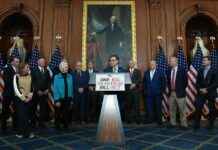As Congress grapples with the decision of whether to extend the Trump tax cuts, a fierce debate rages over who will benefit most from these proposed extensions. Lawmakers on both sides of the aisle have been making bold claims about the potential outcomes, leaving the public to wonder: Will these tax breaks help the middle class, or is this a reverse Robin Hood scam in disguise?
The House Republicans recently passed a budget resolution that paves the way for extending the Tax Cuts and Jobs Act, a significant package of tax cuts that was implemented in 2017 during President Trump’s first term. Many of the tax breaks for individual taxpayers are set to expire after 2025 unless Congress takes action. The GOP has the power to extend these cuts through a simple majority vote in Congress using a legislative tool called budget reconciliation.
On one side of the argument, Rep. Richard Neal, D-Mass., has criticized the Republicans’ policy plan, labeling it a “reverse Robin Hood scam” that favors the wealthy at the expense of the poor. Conversely, Republicans like Rep. Jason Smith, R-Missouri, argue that low- and middle-income households will be the primary beneficiaries of the proposed tax cut extensions.
Economists and tax experts agree that the truth lies somewhere in the middle. “The interesting thing is both can be true, depending on how you interpret what they’re saying,” said James Hines, a law and economics professor at the University of Michigan.
## Middle-Class Benefits and Wealth Disparities
The Trump tax cuts, enacted in 2017, were intended to benefit a wide range of Americans across different income levels. These cuts included provisions such as a larger child tax credit and an expanded standard deduction, aimed at reducing the tax burden on low and middle earners. However, lower marginal tax rates and deductions for business owners largely favored the wealthy.
Analysts predict that if the provisions of the Tax Cuts and Jobs Act are extended, 62% of tax filers would see lower tax bills in 2026 compared to if these measures expire. Without an extension, many individuals would face increased tax liabilities next year. The Tax Foundation estimates that Americans would experience a 2.9% income boost after taxes in 2026 if these provisions are maintained.
Additionally, a U.S. Treasury Department report suggests that extending the Trump tax law would result in a 2.2% tax cut for the average individual. This tax relief would benefit all income groups, with lower earners seeing an improvement in their after-tax income.
## Wealth Disparities and Policy Implications
While the tax cuts may offer some relief to working-class Americans, the largest benefits of these extensions would flow to the highest-income households. According to analyses by the Urban-Brookings Tax Policy Center and the Penn Wharton Budget Model, the top 5% of income earners stand to gain the most from the proposed tax cut extensions.
Democrats have raised concerns about the disproportionate benefits accruing to the wealthy, especially when coupled with potential cuts to programs like Medicaid and food stamps that primarily support lower-income individuals. The combination of tax cuts and spending reductions could leave low-income households worse off, despite the anticipated economic growth.
Experts emphasize that the U.S. income-tax system is designed to be progressive, with higher earners shouldering a larger share of the overall tax burden. While the top 1% of households contribute significantly to tax revenues, they also receive substantial benefits from the proposed tax cuts. Democrats argue that these benefits disproportionately favor the wealthy, while Republicans contend that the tax cuts are proportionate to what individuals were originally paying.
In conclusion, the debate over the extension of the Trump tax cuts is multifaceted and complex. While there are valid arguments on both sides, the ultimate impact of these policy decisions remains uncertain. As lawmakers continue to deliberate, it is essential to consider the implications for different income groups and the broader economy. The outcome of this debate will have far-reaching consequences for American taxpayers and the future of the nation’s tax policy.
















